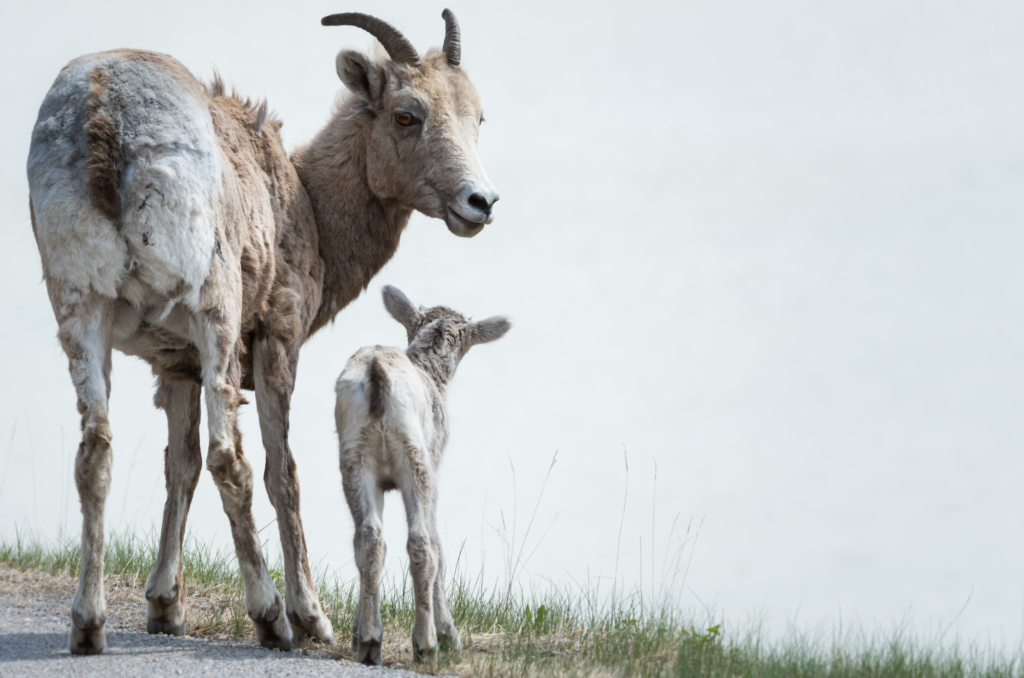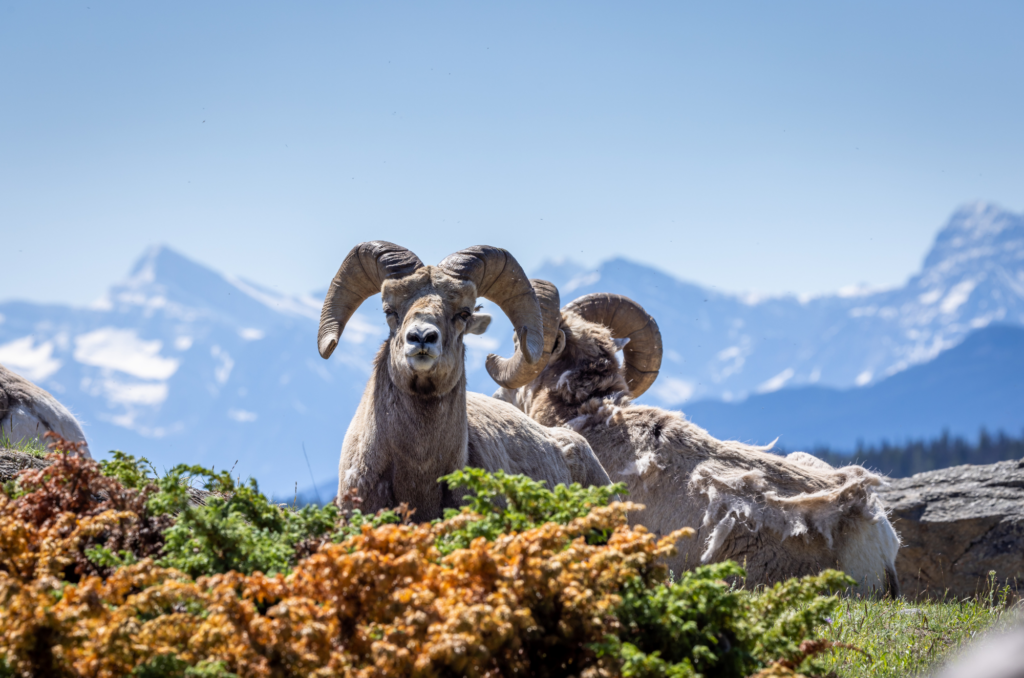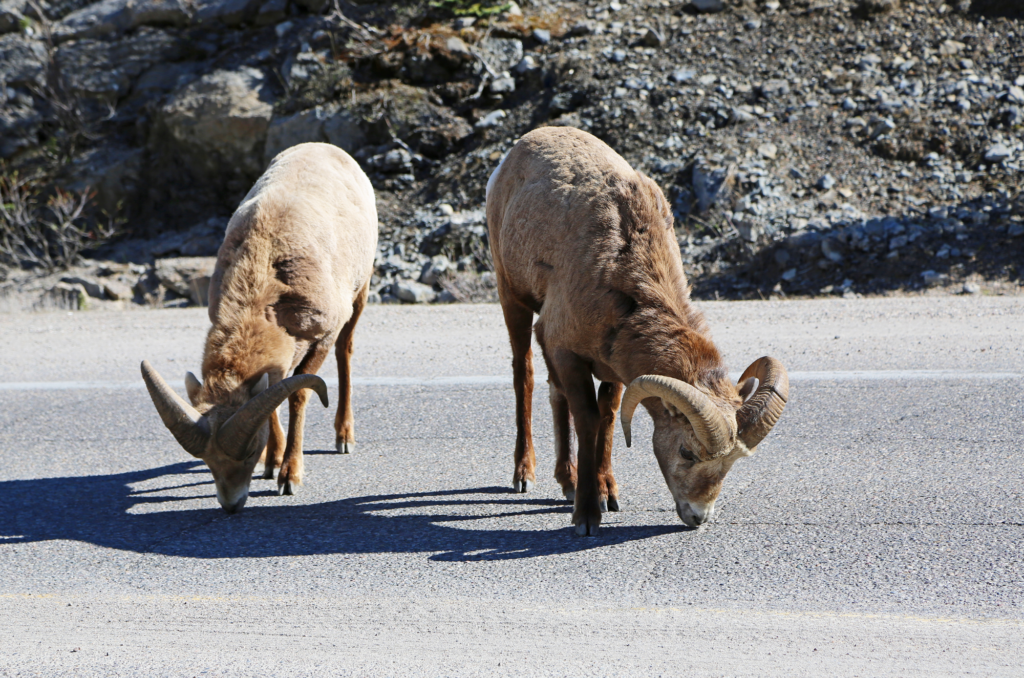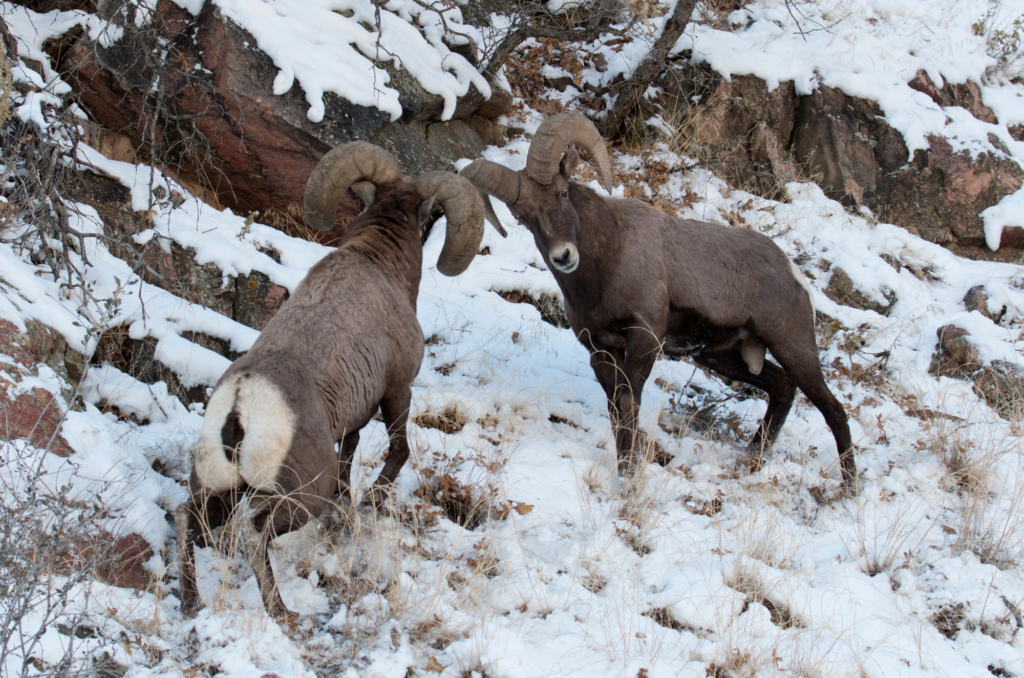Bighorn Sheep: Athletes of the Mountains
Thanks to our Nature Network partner The Alberta Institute for Wildlife Conservation for sharing this month’s blog, which appeared previously on their website.
Have you ever driven down a winding mountain road, turned the corner, and been met with dozens of sheep perched on the rocky cliff side next to the road? Or possibly you’ve been lucky enough to witness the clash between rams, locking their horns in a head-to-head battle. If so, you may already be familiar with bighorn sheep. Let’s dive into this interesting species, and learn a little bit more about Alberta’s provincial mammal.

Rams, Ewes and Lambs
First and foremost, the sheep’s defining feature are the big horns that give them their name. These horns can weigh over 13 kilograms, and grow continuously throughout the life of the sheep1. Adult males, called rams, have the largest horns that curl down near eye level. The horns also show how old the sheep is; much like the rings on a tree trunk, the number of lines on the horn corresponds with age.2 Female sheep, called ewes, are smaller than rams, with shorter, slightly curved horns.4 Sheep have rough, split hooves which help them navigate the rugged mountain landscape. They can climb quickly uphill (up to 24 km/h) and jump six meters horizontally.4 Along with this strength and speed comes agility, and they can comfortably stand on rocky ledges as small as five centimeters wide.4 They also have excellent eyesight, and can detect moving objects over a kilometer in the distance.2
Habitat

Bighorn sheep can be found in the Canadian Rockies from British Columbia and Alberta all the way down to northern Mexico.1 Sheep prefer dry, grassy, treeless areas. They move from lower elevations in the winter to higher alpine elevations in the summer.7 Sheep move between summer and winter ranges, and make use of many different types of habitats to meet their needs at the time.7 Generally, all preferred habitats have some form of steep slope. Reasons for moving between habitats can be to find grazing or mineral licks, avoid heavy snowfall, hide from predators, and to move to a safe area for lambing season.7 Lambs are born on high ledges, away from the reach of typical predators, like cougars, lynx, wolves and other large, carnivorous animals.4
Diet

Sheep are herbivorous grazers, and prefer to forage for low grasses and herbs. They also eat roots, lupine, and shrubs, and will eat conifers and other woody plants in the winter.2
This is where a sheep’s diet gets… rocky. To get their necessary minerals, sheep will travel a long way to reach a mineral lick.3 These are naturally occurring deposits full of many essential nutrients that animals will actually lick to supplement their diets. Sheep are also known to lick roads for salt and eat gravel – but don’t worry! It provides minerals as well and helps with digestion.3
Herds and Battles

If you’ve ever been caught in a sheep crossing, you’ll already know that sheep move in large herds. Sheep are social creatures, and follow a hierarchy. The herds are typically split by sex, with ewes and the young together, and rams making up separate herds.7 The older ewes are in charge of the herd, and lead them between grazing areas.3 The young males leave the ewes’ herd at age 2 or 3, and join a group of other males.7 To determine the dominant male, rams will engage in head-butting battles. They rear up on their hind legs and charge, crashing their horns together until one ram gives in.5 This competition determines the males that have the right to breed for that season. Young rams don’t typically breed until they are strong enough to win the fights – around 7 years old.5 The dominant males are typically the biggest ones with the largest horns.
Conservation Status and Threats
To date, the conservation status of bighorn sheep has remained as secure – meaning they are not currently at risk. There are an estimated 9,000 bighorn sheep currently living in Alberta, with the population in North America reaching 40,000.6 Bighorn sheep populations declined steeply in the 1800s, partly due to trophy hunting, and has not recovered to original levels.6 Several programs exist to maintain and protect this important species from potential threats here in Alberta,6 such as monitoring herd size and protecting sheep winter ranges. Other threats to bighorn populations are disease, predation, and habitat loss.
Bighorn sheep are at high risk for disease and have experienced periodic events where large percentages of the herd died off.6 In 1982, for example, an outbreak of pneumonia killed 300 out of 400 total sheep in southwestern Alberta.6 Stressors that can increase susceptibility to disease are mineral deficiency, harsh weather, habitat loss and lack of healthy grazing areas.6 Preventing bighorn sheep from interacting with domestic sheep and goats can reduce the chance of spreading diseases, and maintain healthy herds.6
Want to help Canadian species like the bighorn sheep and more? Stay tuned with the latest in Canadian nature by subscribing for email updates. You’ll receive regular updates about what we’re doing to protect Canadian nature and how you can help.
References:
-
- Donald A. Blood, “Bighorn Sheep in British Columbia,” Government of British Columbia, March 14, 2000, https://www.env.gov.bc.ca/wld/documents/bighorn.pdf
- Rebecca Kennedy, “The Bighorn Sheep: Majestic and Memorable,” Discover Nature, Nature Canada, accessed May 20, 2024, https://naturecanada.ca/discover-nature/land-wildlife/the-bighorn-sheep-majestic-and-memorable/
- “Bighorn Sheep,” Friends of Kananaskis, accessed May 20, 2024, https://kananaskis.org/bighorn-sheep/
- Alina Bradford, “Rams: Facts About Male Bighorn Sheep,” LiveScience, September 27, 2017, https://www.livescience.com/27724-rams.html
- “Bighorn Sheep,” National Wildlife Federation, accessed May 20, 2024, https://www.nwf.org/Educational-Resources/Wildlife-Guide/Mammals/Bighorn-Sheep
- “Pneumonia and Bighorn Sheep,” Government of Alberta, accessed May 22, 2024, https://www.alberta.ca/pneumonia-and-bighorn-sheep
- R.A. Demarchi, “Bighorn Sheep,” Government of British Columbia, February 5, 2004, https://www.env.gov.bc.ca/wld/frpa/iwms/documents/Mammals/m_bighornsheep.pdf



